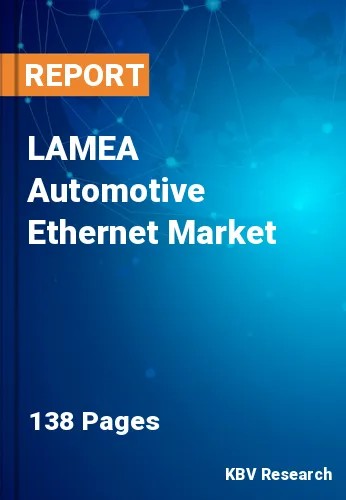The Latin America, Middle East and Africa Automotive Ethernet Market would witness market growth of 16.0% CAGR during the forecast period (2023-2030).
One of the transformative applications of AI in automotive Ethernet is predictive maintenance. AI algorithms analyze data from various vehicle components connected through the Ethernet network to identify patterns indicative of potential issues or wear and tear. Automakers can proactively schedule maintenance by predicting maintenance needs, reducing downtime, and preventing unexpected breakdowns. This predictive approach enhances vehicle reliability, cost savings, and improved customer satisfaction.
Moreover, as the automotive industry embraces sustainability, innovations in this type of Ethernet include eco-friendly features. This involves optimizing network communication to minimize energy consumption, contributing to the overall goal of creating environmentally conscious vehicles. An important advancement is incorporating sophisticated power management techniques into its systems. These strategies involve dynamically adjusting power levels based on network demand. During low data traffic periods, Ethernet system components can enter low-power modes or reduce their operating frequencies, leading to substantial energy savings. This adaptive approach ensures that energy is allocated efficiently, aligning with the broader goals of sustainable automotive technology.
Saudi Arabia has been actively fostering the development of a domestic automotive manufacturing ecosystem. Investments in building manufacturing plants and assembly lines contribute to the local production of vehicles. As the automotive sector expands, incorporating advanced technologies like this type of Ethernet enhances locally produced vehicles' efficiency, safety, and connectivity features. As per the data from the International Trade Administration, the automotive sector in Middle East/North Africa (MENA) region is growing at an estimated 36%, with Saudi Arabia as the leading regional market. Saudi Arabia accounted for almost 52% of the vehicles sold in the Gulf Cooperation Council (GCC) and 35% in the MENA region in 2020. The total number of vehicles sold in Saudi Arabia in 2019 and 2020 was 556,000 and 436,000, respectively, and sales are projected to reach 543,000 units by 2025. Hence, the growing demand for autonomous vehicles and automotive sector expansion in LAMEA will boost the demand for automotive Ethernet in the region.
The Brazil market dominated the LAMEA Automotive Ethernet Market by Country in 2022, and would continue to be a dominant market till 2030; thereby, achieving a market value of $124.6 million by 2030. The Argentina market is showcasing a CAGR of 17.3% during (2023 - 2030). Additionally, The UAE market would register a CAGR of 16.3% during (2023 - 2030).
Free Valuable Insights: The Worldwide Automotive Ethernet Market is Projected to reach USD 6.4 Billion by 2030, at a CAGR of 14.2%
Based on Vehicle Type, the market is segmented into Passenger Cars, and Commercial Vehicles. Based on Component, the market is segmented into Hardware, Software, and Services. Based on Application, the market is segmented into Driver Assistance, Infotainment, Powertrain, Chassis, Body and Comfort, and Others. Based on countries, the market is segmented into Brazil, Argentina, UAE, Saudi Arabia, South Africa, Nigeria, and Rest of LAMEA.
By Vehicle Type
By Component
By Application
By Country
Our team of dedicated experts can provide you with attractive expansion opportunities for your business.

